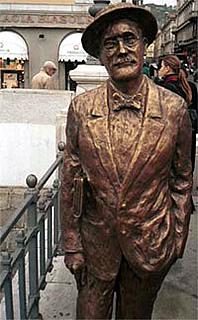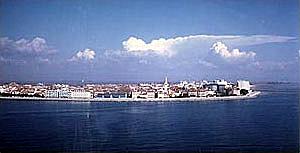Trieste is an Adriatic coastal city in north eastern Italy, close to the border with Slovenia. The sea in the Gulf of Trieste is very clear and clean, with limestone cliffs and rocky beaches. The centre of the city has a mid-European feel, more Austrian than Italian, Trieste was the seaport of the Hapsburg Empire. Here you can enjoy a combination of a sea/beach holiday and the attractions of a cultural city.
It is an ideal destination for a short break but you could easily spend a week here. The Verdi Theatre hosts an opera season in the winter and an operetta festival in summer. You can swim in the beautiful clear sea, stroll the promenade, and walk along the cliff paths. Take in the wonderful art collection at the Revoltella Museum. You can sip coffee on Piazza Unita Italia with its grand 19th century buildings, which face onto the sea.
History: according to folklore, Trieste was founded by Tergeste, a friend of Jason and the Argonauts. Ancient Tergeste as a Roman colony is dated to around 178 BC. It became more important during the reign of Octavian when roads were improved. The city has had many rulers during its history: Goths, Byzantines, and Lombards. In the 13th century Trieste was forced to swear allegiance to Venice. To escape Venetian domination, Trieste sought the protection of Duke Leopold of Austria. Trieste was of great importance to the Hapsburg Empire as a seaport and was made a Freeport in 1719. Without customs barriers the port and city flourished. At the end of the First World War with collapse of the Hapsburg Empire, Trieste was returned to Italy in 1918. Trieste was taken over by the Third Riech when Italy withdrew from the Second World Ward in September 1943. Two years later there was a 40-day Occupation by Tito's Yugoslav forces. After 9 years under an Anglo-American government Trieste was handed over to the Italian government.
Trieste's history may help explain why 70% of Italians apparently did not know that Trieste was part of Italy in a recent opinion poll! With EU enlargement Trieste is ideally placed as the only natural port in the centre of Europe. Trieste is one of three finalists to host the international Expo of Science, Technology and Culture in 2008. If its bid is successful there will be more investment in the area and Trieste will become better known on the world map.
Literary Connections: the Irish author James Joyce lived
in Trieste during the early part of the 20th century. When he
first arrived he worked as a tutor at the Berlitz School of
English. He went on to write “The Dubliners”, “The
Portrait of an Artist as a Young Man” and start
“Ulysses” in Trieste. The rich mix of central European
and Eastern Mediterranean culture in Trieste is said to have had
a great influence on his writing.
Joyce (pictured left) was English tutor to Itali Svevo, the Italian novelist. Svevo was born in Trieste in 1861, his Mother was part of a Triestian Jewish family, and his Father was of German descent. Joyce encouraged and praised Svevo's work and Svevo wrote critiques of Joyce's work.
Jan Morris wrote the book, “Trieste and the Meaning of Nowhere”. Morris claims this is her final book, a self-examination based in Trieste. Morris changed gender. Jan Morris first visited Trieste at the end of the Second World War as young Welsh soldier. She describes how the city “curiously haunted her” . She revisited the city as an elderly woman.
Morris describes Trieste as “natural capital of the nation of nowhere”. By this she means a home for the so-called “Fourth World”. This is a scattered group with the common values of humour and understanding, usually exiles in their own communities but probably numerous enough to form their own nation.
I laughed at Clay Risen's comment in his piece about Trieste in the Square Table in Spring 2003. He observed that “Trieste is the only city in Europe which appears more often in reflective essays than in guide books of newspaper travel sections.”
Exploring the city: the best way to explore the city is to walk around. The Piazza dell' Unita d'Italia is the heart of the city. The square was created towards the end of the 19th century. It houses the City Hall, with its clock tower featuring statues of Mikeze and Lakeze, figures from Trieste folklore; Government House, with its gilded mosaic wall decorations; and the former Head Office of Lloyd Triestino, built in Renaissance style by an Austrian architect.
The Victory Lighthouse lights the Gulf of Trieste and commemorates the dead of the First World War. It stands almost 70 metres high with a scaled dome containing a statue of winged Victory. At the base of the column is the anchor of the torpedo boat Audace, the first Italian ship to enter the harbour in 1918. The lighthouse took 4 years to complete and was officially opened in 1927.
The Old Stock Exchange (see picture right) is a fine example of
neo-classical architecture, resembling a Greek temple. The Old
Stock Exchange stands by the so called Grand Canal. However this
is rather a misnomer as the canal is very short.
The Arco di Riccard is a Roman gate to the city thought to date from 33 AD. It is in Piazzetta di Ricordo in the old city. You can see the Roman amphitheatre at the foot of San Guisto hill. The Verdi Opera Theatre opened in 1801. It is of a similar style to La Scala in Milan. The Arco di Riccard is a Roman gate to the city thought to date from 33 AD. It is in Piazzetta di Ricordo in the old city. You can see the Roman amphitheatre at the foot of San Guisto hill. The Verdi Opera Theatre opened in 1801. It is of a similar style to La Scala in Milan.
Day Trips: there are many day trips that can be taken, including exploring the Carse. The Triestine carse starts at Montefalcone in the north and stretches down adjacent to the Slovenian border. The area is known as a paradise for botanists with a mixture of continental flora and Mediterranean vegetation. There is talk of the area achieving national park status. The Carsic house in Rupingrande has a collection of traditional furniture and local costumes. During the first week in May the works of local painters are exhibited during the Majence Festival, in San Dorligo delle Valle. The best known event is the Carsic Wedding, every second year on the last Sunday of August in Monrupino. There are dances every night of the preceding week. On the wedding day the bridal procession, all dressed in traditional costume, walk to the fortress church for the marriage ceremony.
Grado and Aquiliea : Aquiliea was founded in the first century BC. It occupies a strategic defence location. It became a Patriarch's seat and many beautiful churches were built. The Bascilica is considered to be one of the most important monuments of early Christianity. There are two museums to visit there.
Grado was the extreme southern part of the port of Aquileia (see
picture below left). Now it a beautiful island city joined to the
mainland by a causeway. It boasts 20 kms of fine sandy beaches.
Grado was very popular as a spa during the days of the Austrio
Hungarian Empire with its healing sands. Grado can be reached by the no 21
bus from Trieste. There is also a boat service during the Summer.
Grado can be reached by the no 21
bus from Trieste. There is also a boat service during the Summer.
Muggia: Muggia (see picture below right) is a pretty coastal town just south of Trieste, which can be reached by ferry from Trieste during the summer. The town is of Venetian origin, surrounded by medieval walls with a 14th century castle and a pretty port.
 The Slovenian border is just a few
kilometres from Trieste. The Lipica Stud and
Riding School is under a half hour drive from Trieste. It was
originally founded in 1580 by Archduke Charles for breeding royal
horses for the Austrian court. Now you can tour the stud farm (6
Euros) or have a riding lesson, starting at 16 euros.
The Slovenian border is just a few
kilometres from Trieste. The Lipica Stud and
Riding School is under a half hour drive from Trieste. It was
originally founded in 1580 by Archduke Charles for breeding royal
horses for the Austrian court. Now you can tour the stud farm (6
Euros) or have a riding lesson, starting at 16 euros.
Croatia can be easily reached through by passing through the narrow strip of coastal Slovenia. Venice can be reached by direct train from Trieste. The journey takes around two hours. The train takes you right into the centre of Venice.
Getting there and around: Ryanair flies into Trieste from London Stansted. The airport is 35 kms west of Trieste but there is regular public transport on Coach 51 into Trieste. If you do decide to hire a car, it is worth checking that you can take it into Slovenia and Croatia if you are considering day trips there. Trieste has a good public transport network. There is a “Trieste by Bus” city tour in 13 stops. This is available on Saturdays and Sundays at 2pm from the end of June to mid October. The two and a half hour trip allows you to see the city's main attractions. The cost is around five euros per person. You can take the Opicani tram up to the Carso plateau, 348 metres above sea level. This funicular tramway was built in 1902. The tram leaves from Piazza Oberdan in the city centre up Scorolo hill to the plateau above.
Karen Bryan is an independent travel consultant and writer, specialising in less well known destinations in Europe. Her websites are: www.europealacarte.co.uk, www.europe-culture-activity-tours.com
